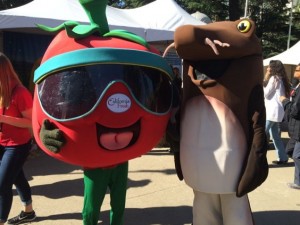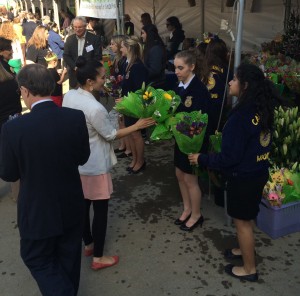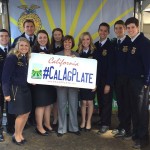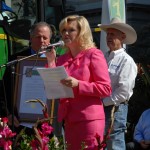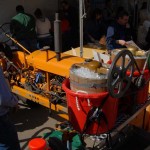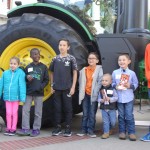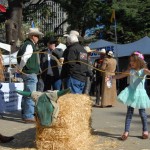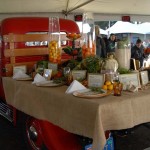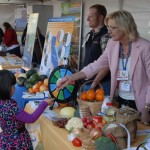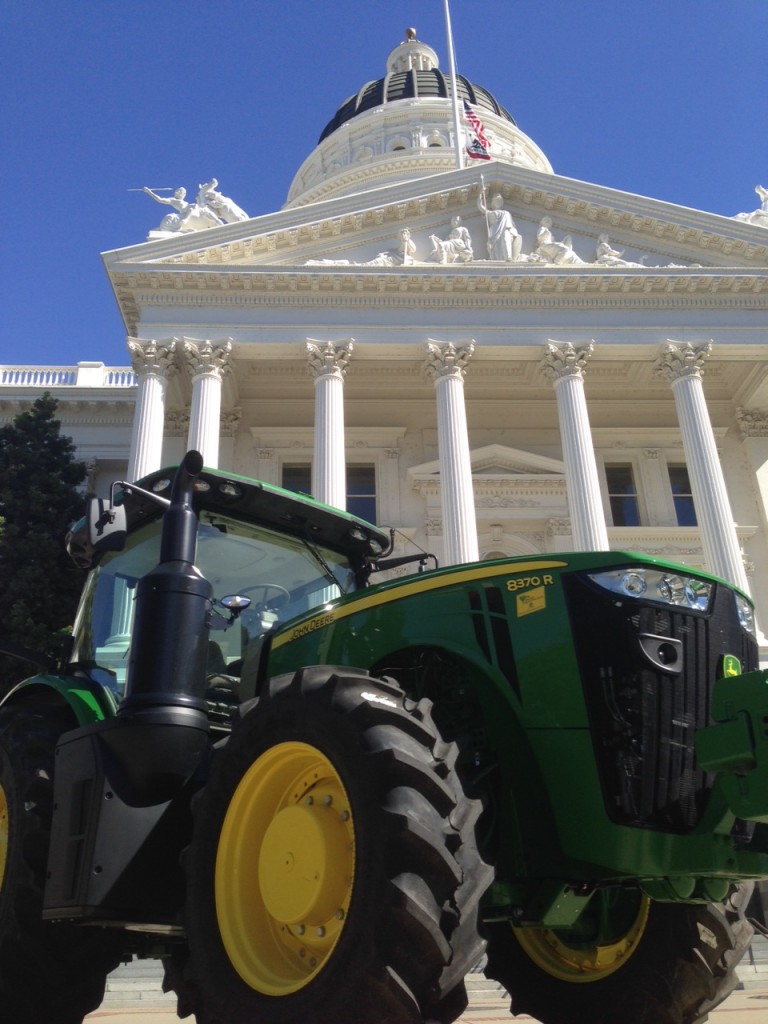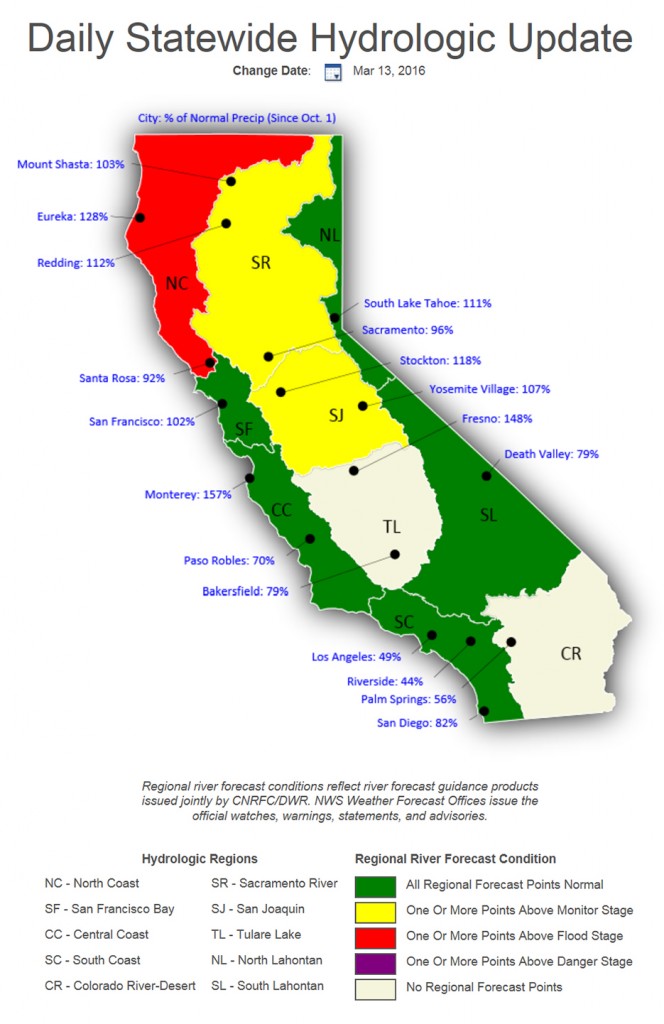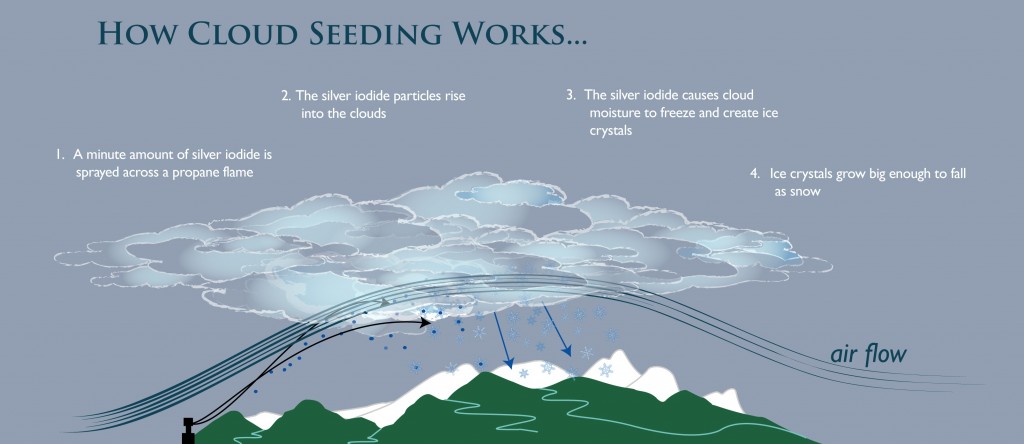-
Recent Posts
- Animal Care and Youth Education at California Fairs
- Nutrition Incentive Grants help CalFresh recipients purchase more California-grown fruits and vegetables
- CDFA’s Progress for Californians — the vast reach of Farm to School
- CDFA congratulates staff for completing coaching program — an important step in developing leadership skills
- Join Secretary Ross in celebrating Public Service Recognition Week 2025
Recent Comments
- Stacy Hackney on Despite Tariffs, California Continues Trade Engagement
- Keshav Boddula on Earth Week spotlight — CDFA Food Recovery webpage offers resources for reducing food waste
- Don’t Worry, US Investors Can Still Make Offshore Wind Happen … Somewhere – Bruce Beach CA News on California Peaches and Nectarines Arrive in Vietnam! New Export Market Opens for California Products
- US Investors Can Still Make Offshore Wind Happen…In Vietnam - Oilandinvest.com on California Peaches and Nectarines Arrive in Vietnam! New Export Market Opens for California Products
- US Investors Can Still Make Offshore Wind Happen…In Vietnam - nrinvesting.com on California Peaches and Nectarines Arrive in Vietnam! New Export Market Opens for California Products
Archives
- May 2025
- April 2025
- March 2025
- February 2025
- January 2025
- December 2024
- November 2024
- October 2024
- September 2024
- August 2024
- July 2024
- June 2024
- May 2024
- April 2024
- March 2024
- February 2024
- January 2024
- December 2023
- November 2023
- October 2023
- September 2023
- August 2023
- July 2023
- June 2023
- May 2023
- April 2023
- March 2023
- February 2023
- January 2023
- December 2022
- November 2022
- October 2022
- September 2022
- August 2022
- July 2022
- June 2022
- May 2022
- April 2022
- March 2022
- February 2022
- January 2022
- December 2021
- November 2021
- October 2021
- September 2021
- August 2021
- July 2021
- June 2021
- May 2021
- April 2021
- March 2021
- February 2021
- January 2021
- December 2020
- November 2020
- October 2020
- September 2020
- August 2020
- July 2020
- June 2020
- May 2020
- April 2020
- March 2020
- February 2020
- January 2020
- December 2019
- November 2019
- October 2019
- September 2019
- August 2019
- July 2019
- June 2019
- May 2019
- April 2019
- March 2019
- February 2019
- January 2019
- December 2018
- November 2018
- October 2018
- September 2018
- August 2018
- July 2018
- June 2018
- May 2018
- April 2018
- March 2018
- February 2018
- January 2018
- December 2017
- November 2017
- October 2017
- September 2017
- August 2017
- July 2017
- June 2017
- May 2017
- April 2017
- March 2017
- February 2017
- January 2017
- December 2016
- November 2016
- October 2016
- September 2016
- August 2016
- July 2016
- June 2016
- May 2016
- April 2016
- March 2016
- February 2016
- January 2016
- December 2015
- November 2015
- October 2015
- September 2015
- August 2015
- July 2015
- June 2015
- May 2015
- April 2015
- March 2015
- February 2015
- January 2015
- December 2014
- November 2014
- October 2014
- September 2014
- August 2014
- July 2014
- June 2014
- May 2014
- April 2014
- March 2014
- February 2014
- January 2014
- December 2013
- November 2013
- October 2013
- September 2013
- August 2013
- July 2013
- June 2013
- May 2013
- April 2013
- March 2013
- February 2013
- January 2013
- December 2012
- November 2012
- October 2012
- September 2012
- August 2012
- July 2012
- June 2012
- May 2012
- April 2012
- March 2012
- February 2012
- January 2012
- December 2011
- November 2011
- October 2011
- September 2011
- August 2011
- July 2011
- June 2011
Categories
- AG Vision
- Agricultural Education
- Agricultural Marketing
- Alternative Fuels
- Animal health
- Animal Welfare
- Asian Citrus Psyllid
- Biodiversity
- Border stations
- BSE
- Cannabis
- Cannella Panel
- Climate Change
- Climate Smart Agriculture
- Community-based Food System
- Conservation
- Dairy
- Drought
- Environment
- Fairs
- Farm Bill
- Farm Labor
- Farmers' Markets
- Fertilizer
- Food Access
- Food Safety
- Food Waste
- Glassy-winged Sharpshooter
- Growing California
- Healthy soils
- HLB
- Hydrogen
- Integrated Pest Management (IPM)
- Invasive Species
- Light Brown Apple Moth
- Livestock ID
- Measurement Standards
- Nutrition
- Organic agriculture
- Pierce's Disease
- Pollinators
- Specialty Crops
- State Board of Food and Agriculture
- Succession Planning
- Trade
- Uncategorized
Pages
RSS

#CalAgDay highlights

Secretary Ross today at #CalAgDay, “Thank you not only to the farmers and ranchers, but also to all of the hands and hearts and minds that touch the food that comes to our table. “
- Secretary Ross with a swarm of FFA “blue jackets” at Ag Day, supporting the California Agriculture license plate program that helps fund ag education and leadership programs.
- California Women for Agriculture President Jeanette Lombardo (center) with California rodeo queens.
- CDFA Secretary Karen Ross with Ag Day emcee and Your Produce Man Michael Marks.
- CDFA Secretary Karen Ross says “Hello” to Imagine This contest winners, who wrote stories about agriculture as part of the annual competition hosted by the California Foundation for Agriculture in the Classroom.
- Senate Agriculture Committee Chair Cathleen Galgiani and her colleague, Assembly Agriculture Committee Chair Bill Dodd (left) presented a resolution honoring Bob Fox (right), who wears many hats in the equine/rodeo/agricultural realm – including being a longtime supporter of Ag Day.
- Secretary Ross reminding the audience where California ranks in agriculture.
- Secretary Ross with the rodeo queens.
- Yes, that really is a tractor that makes ice cream.
- California Grown is a great frame of mind for Ag Day.
- Rodeo queens and charros, two Ag Day traditions.
- Customs and Border Protection’s inspector dogs got plenty of attention at Ag Day.
- Welcome to the State Cowpital!
- FFA students helped hand out flowers at the California State Floral Association booth.
- Senate Agriculture Committee Chair Cathleen Galgiani stops by the CDFA booth to talk about dairy digesters and efficient use of water on farms.
- Kids + tractors = magic
- Roping lessons from a real rodeo queen. That’s Ag Day, folks.
- The ever-popular alpaca pen.
- This beautiful display was part of the California State Fair booth.
- UC ANR’s Jeanette Warnert “passing it on.”
Posted in Uncategorized
Leave a comment
#CalAgDay set-up begins!
Join us tomorrow at 11:30 am at the west steps of the State Capitol! Post any pictures with the hashtag #CalAgDay
Posted in Uncategorized
Leave a comment
USDA farm-to-school programs invest nearly $800 million in local economies
Schools across the United States purchased $789 million in local foods from farmers, ranchers, fishermen, and food processors and manufacturers in school year 2013 – 2014, according to results from the U.S. Department of Agriculture (USDA) Farm to School Census released today. That represents a 105 percent increase over the 2011-2012 school year when the first census was conducted, signifying the deepening commitment of schools nationwide to bring local food into the cafeteria and strengthen their local economies.
Schools report that farm to school programs can increase the number of students purchasing school breakfast and lunch, improve consumption of healthier foods at school, and reduce plate waste. The programs are often also heavily focused on nutrition education, helping teach children where their food comes from and exposing them to lessons about healthy eating. The census data show that school gardens, which can be both teaching tools and a sources of fresh produce, have nearly tripled over the past two years.
In California 55 percent of school districts surveyed say they participate in farm-to-school activities. That number represents 373 school districts, nearly 5,500 schools and more than 3.4 million students. Nationally, 42 percent of school districts that responded to the census are operating farm to school programs as of the 2014-2015 school year, and another 16 percent – more than 2,000 districts – have plans to start in the future.
The newly updated Farm to School Census website allows users to find information about farm to school programs in their state and in their particular school or district. The site also names three top school districts in each state that boast higher than average investment in local food purchasing. In addition, users can vote for a school that they believe administers a creative, innovative, and/or exemplary farm to school program for the “One in a Melon” award. Nominations will be accepted through April 15.
In order to establish realistic goals with regard to increasing the availability of local foods in schools, USDA conducted the first nationwide Farm to School Census in 2013. USDA conducted a second Farm to School Census in 2015 to measure progress towards reaching this goal. In 2015, USDA surveyed over 18,000 public, private and charter school districts and 12,585 school districts responded for a response rate of approximately 70 percent. Data were collected through an online survey and through a printable mail-in questionnaire. To view the full results, visit https://farmtoschoolcensus.fns.usda.gov.
Posted in Uncategorized
2 Comments
How humans help make it rain – from ABC News
By Alyssa Newcomb
California has been battling one of the most severe droughts in the state’s history, but with El Niño bringing storm clouds in over the Golden State, officials saw an opportunity to make it rain.
The Los Angeles County Department of Public Works was delighted at the prospect of some much-needed rain coming to the area and jumped at the chance to help increase the amount of rainfall the storm brought by intervening in a process known as cloud seeding. Monday’s storm was the first time that cloud seeding had been done by the Department of Public Works since 2002, according to the Los Angeles Times.
Yes, humans can actually modify the weather and it’s been going on for decades. Here’s the lowdown on how cloud seeding works.
What Is Cloud Seeding?
Cloud seeding is when humans try to modify the weather by targeting certain areas within clouds, with the goal of increasing rainfall, mitigating the potential damage from hail and clearing fog, according to the American Meteorological Society.
In the case of Los Angeles County, North American Weather Consultants, a Utah-based group, set up generators, which then sprayed silver iodide into the clouds, creating ice particles. Water vapor then froze onto these particles and fell as precipitation.
Wait, So Humans Can Really Modify the Weather?
Yes! It’s been going on all over the world for decades.
“Attempts to modify the weather have been conducted for centuries. However, modern cloud seeding dates from the late 1940’s, springing from a discovery at the General Electric labs in Schenectady, New York, in 1946,” according to North American Weather Consultants’ website.
Don Griffith, president of the group, told ABC News that “the beneficiaries typically are municipal water supply groups and irrigated agriculture groups that wish to enhance the snowfall so they can get better spring and summer runoff.”
How Effective Is Cloud Seeding?
Various research journals differ on this since there isn’t an opportunity to create a controlled experiment. However, in the case of California’s latest storm, the county estimated it resulted in 15 percent more rainfall, according to the LA Times.
Posted in Uncategorized
1 Comment
California’s 2015 Grape Crush Report Released
From the National Agricultural Statistics Service (NASS)
SACRAMENTO – The 2015 grape crush totaled 3,867,710 tons, down 7 percent from the 2014 crush of 4,144,534 tons. Red wine varieties accounted for the largest share of all grapes crushed, at 2,040,781 tons, down 5 percent from 2014. The 2015 white wine variety crush totaled 1,663,790 tons, down 5 percent from 2014. Tons crushed of raisin type varieties totaled 92,432, down 41 percent from 2014, and tons crushed of table type varieties totaled 70,708, down 25 percent from 2014.
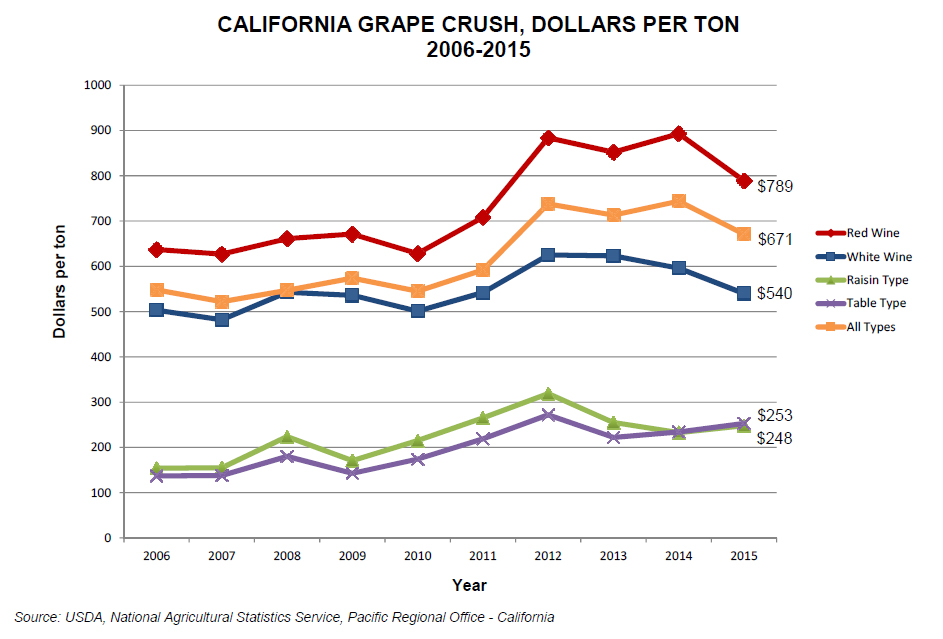 The 2015 average price of all grape varieties was $671.31, down 10 percent from 2014. Average prices for the 2015 crop by type were as follows: red wine grapes, $789.46, down 12 percent from 2014; white wine grapes, $540.24, down 9 percent from 2014; raisin grapes, $247.52, up 6 percent; and table grapes, $252.63, up 8 percent.
The 2015 average price of all grape varieties was $671.31, down 10 percent from 2014. Average prices for the 2015 crop by type were as follows: red wine grapes, $789.46, down 12 percent from 2014; white wine grapes, $540.24, down 9 percent from 2014; raisin grapes, $247.52, up 6 percent; and table grapes, $252.63, up 8 percent.
In 2015, Chardonnay continued to account for the largest percentage of the total grape crush volume with 16.4 percent. Cabernet Sauvignon accounted for the second leading percentage of crush with 11.8 percent. The next eight highest percentages of grapes crushed included only wine grape varieties. Thompson Seedless, the leading raisin grape variety crushed for 2015, held 2.0 percent of the total crush.
Grapes produced in District 4 (Napa County) received the highest average price of $4,335.80 per ton, up 6 percent from 2014. District 3 (Sonoma and Marin counties) received the second highest return of $2,442.99, up 5 percent from 2014. The 2015 Chardonnay price of $787.97 was down 8 percent from 2014, and the Cabernet Sauvignon price of $1,316.09 was also down 8 percent from 2014. The 2015 average price for Zinfandel was $574.80, down 8 percent from 2014, while the Merlot average price was down 4 percent from 2014 at $740.83 per ton.
The Final Grape Crush Report includes all grape tonnage crushed during the 2015 season. It also includes purchased tonnage and pricing information for grapes with final prices prior to January 10, 2015.
The entire Grape Crush Report is available online at www.nass.usda.gov/ca.
View the original press release online here.
Two videos on the Asian Citrus Psyllid and Huanglongbing – How to check your trees; Florida’s story
Thank you to the University of California’s Division of Agriculture and Natural Resources and to California Citrus Mutual.
Posted in Asian Citrus Psyllid, HLB, Invasive Species
Leave a comment



